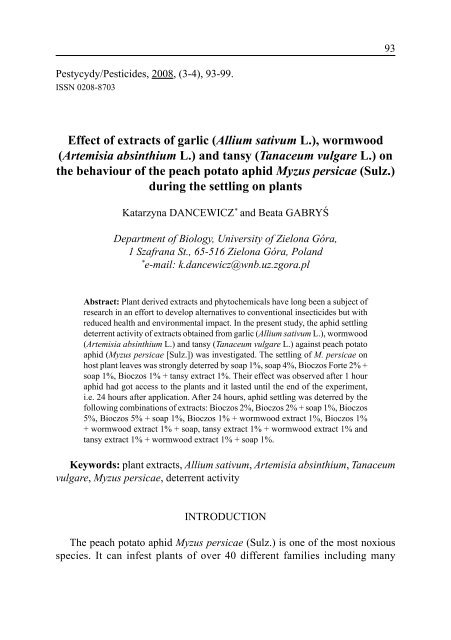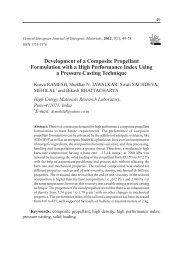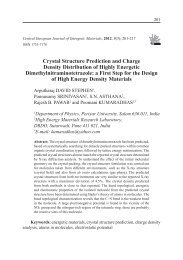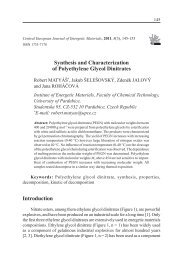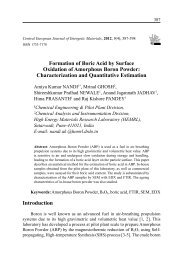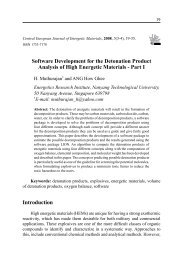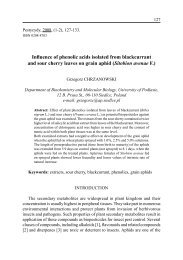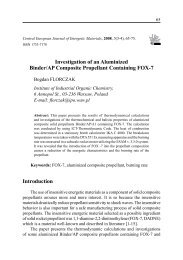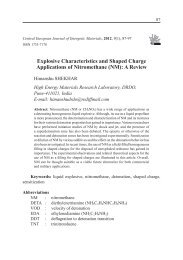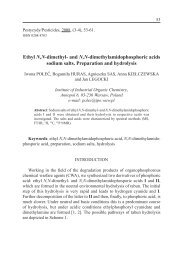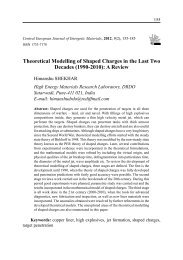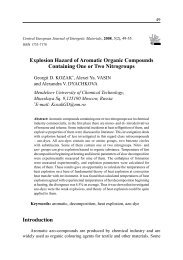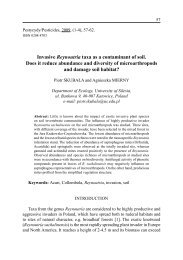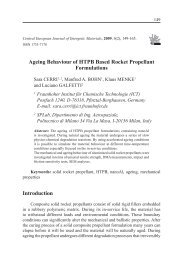Effect of extracts of garlic (Allium sativum L.), wormwood (Artemisia ...
Effect of extracts of garlic (Allium sativum L.), wormwood (Artemisia ...
Effect of extracts of garlic (Allium sativum L.), wormwood (Artemisia ...
Create successful ePaper yourself
Turn your PDF publications into a flip-book with our unique Google optimized e-Paper software.
<strong>Effect</strong> <strong>of</strong> <strong>extracts</strong> <strong>of</strong> <strong>garlic</strong> (<strong>Allium</strong> <strong>sativum</strong> L.)...<br />
93<br />
Pestycydy/Pesticides, 2008, (3-4), 93-99.<br />
ISSN 0208-8703<br />
<strong>Effect</strong> <strong>of</strong> <strong>extracts</strong> <strong>of</strong> <strong>garlic</strong> (<strong>Allium</strong> <strong>sativum</strong> L.), <strong>wormwood</strong><br />
(<strong>Artemisia</strong> absinthium L.) and tansy (Tanaceum vulgare L.) on<br />
the behaviour <strong>of</strong> the peach potato aphid Myzus persicae (Sulz.)<br />
during the settling on plants<br />
Katarzyna DANCEWICZ * and Beata GABRYŚ<br />
Department <strong>of</strong> Biology, University <strong>of</strong> Zielona Góra,<br />
1 Szafrana St., 65-516 Zielona Góra, Poland<br />
*<br />
e-mail: k.dancewicz@wnb.uz.zgora.pl<br />
Abstract: Plant derived <strong>extracts</strong> and phytochemicals have long been a subject <strong>of</strong><br />
research in an effort to develop alternatives to conventional insecticides but with<br />
reduced health and environmental impact. In the present study, the aphid settling<br />
deterrent activity <strong>of</strong> <strong>extracts</strong> obtained from <strong>garlic</strong> (<strong>Allium</strong> <strong>sativum</strong> L.), <strong>wormwood</strong><br />
(<strong>Artemisia</strong> absinthium L.) and tansy (Tanaceum vulgare L.) against peach potato<br />
aphid (Myzus persicae [Sulz.]) was investigated. The settling <strong>of</strong> M. persicae on<br />
host plant leaves was strongly deterred by soap 1%, soap 4%, Bioczos Forte 2% +<br />
soap 1%, Bioczos 1% + tansy extract 1%. Their effect was observed after 1 hour<br />
aphid had got access to the plants and it lasted until the end <strong>of</strong> the experiment,<br />
i.e. 24 hours after application. After 24 hours, aphid settling was deterred by the<br />
following combinations <strong>of</strong> <strong>extracts</strong>: Bioczos 2%, Bioczos 2% + soap 1%, Bioczos<br />
5%, Bioczos 5% + soap 1%, Bioczos 1% + <strong>wormwood</strong> extract 1%, Bioczos 1%<br />
+ <strong>wormwood</strong> extract 1% + soap, tansy extract 1% + <strong>wormwood</strong> extract 1% and<br />
tansy extract 1% + <strong>wormwood</strong> extract 1% + soap 1%.<br />
Keywords: plant <strong>extracts</strong>, <strong>Allium</strong> <strong>sativum</strong>, <strong>Artemisia</strong> absinthium, Tanaceum<br />
vulgare, Myzus persicae, deterrent activity<br />
INTRODUCTION<br />
The peach potato aphid Myzus persicae (Sulz.) is one <strong>of</strong> the most noxious<br />
species. It can infest plants <strong>of</strong> over 40 different families including many
94 K. Dancewicz, B. Gabryś<br />
economically important ones world wide, and it is able to transmit over 100<br />
plant viruses [1].<br />
At present, aphid control depends mainly on the use <strong>of</strong> insecticides. Due to<br />
the repeating applications, many aphid species, especially the peach potato aphid,<br />
have developed resistance to several chemical aphicides [2, 3]. Therefore, an<br />
alternative method <strong>of</strong> aphid control is needed. One <strong>of</strong> the possible approaches<br />
is the use <strong>of</strong> plant <strong>extracts</strong> which would repel aphids or deter their feeding, and<br />
in consequence, reduce their number on plants.<br />
Plant <strong>extracts</strong> obtained from <strong>garlic</strong> (<strong>Allium</strong> <strong>sativum</strong> L.), <strong>wormwood</strong> (<strong>Artemisia</strong><br />
absinthium L.) and tansy (Tanaceum vulgare L.) have a broad spectrum <strong>of</strong><br />
biological activity. Their anti-inflammatory, antibacterial and antifungal activities<br />
are well known [4-11]. Extracts from these plants possess also anti-insect<br />
properties. Methanolic <strong>extracts</strong> <strong>of</strong> <strong>garlic</strong> have been reported to be larvicidal<br />
against larvae <strong>of</strong> several species <strong>of</strong> mosquitoes, cluster caterpillar Spodoptera<br />
litura (Fabricius), and the lymantriid Euproctis sp., [12]. Water <strong>extracts</strong> <strong>of</strong> tansy<br />
have antifeedant and insecticidal effect on larvae and adults <strong>of</strong> some species <strong>of</strong><br />
Lepidoptera and Coleoptera [8, 13]. Also <strong>wormwood</strong> is famous for its antifeedant<br />
properties [4]. In addition, <strong>garlic</strong> and <strong>wormwood</strong> <strong>extracts</strong> have been reported<br />
to exhibit insecticidal activity against aphids M. persicae and Brevicoryne<br />
brassicae [14].<br />
The aim <strong>of</strong> this study was to evaluate the effect <strong>of</strong> <strong>garlic</strong>, <strong>wormwood</strong>, and<br />
tansy <strong>extracts</strong> on the settling <strong>of</strong> M. persicae on plants.<br />
MATERIAL AND METHODS<br />
Aphid and Plants: Aphids (M. persicae) and plants (Chinese cabbage Brassica<br />
pekinensis) were reared in laboratory at 20 °C, 65% r.h., and L16:8D photoperiod.<br />
Young, 2-3 days old viviparous apterous females were selected for experiments.<br />
Cabbage plants used in the bioassays were 5-6 weeks old.<br />
Extracts: The activity <strong>of</strong> the following <strong>extracts</strong> was evaluated:<br />
- Bioczos (1%, 2%, 5%) and Bioczos FORTE (2%) − water <strong>extracts</strong> from<br />
<strong>garlic</strong>;<br />
- Extract <strong>of</strong> <strong>wormwood</strong> 1% ;<br />
- Extract <strong>of</strong> tansy 1% ;<br />
- Potassic horticultural soap (1%, 4%).<br />
The <strong>extracts</strong> were kindly provided by HIMAL company and were used as<br />
water solutions in combination with potassic horticultural soap (E-1 − E-14)<br />
(Table 1). Water was used as a control in all assays.
<strong>Effect</strong> <strong>of</strong> <strong>extracts</strong> <strong>of</strong> <strong>garlic</strong> (<strong>Allium</strong> <strong>sativum</strong> L.)...<br />
95<br />
Table 1. Plant <strong>extracts</strong> and other substances studied for feeding deterrent<br />
activity to Myzus persicae<br />
Symbol<br />
Extracts<br />
E-1 soap 1%<br />
E-2 soap 4%<br />
E-3 Bioczos 2%<br />
E-4 Bioczos 2% + soap 1%<br />
E-5 Bioczos 5%<br />
E-6 Bioczos 5% + soap 1%<br />
E-7 Bioczos FORTE 2%<br />
E-8 Bioczos FORTE 2% + soap 1%<br />
E-9 Bioczos 1% + <strong>wormwood</strong> extract 1%<br />
E-10 Bioczos 1% + <strong>wormwood</strong> extract 1% + soap 1%<br />
E-11 Bioczos 1% + tansy extract 1%<br />
E-12 Bioczos 1% + tansy extract 1% + soap 1%<br />
E-13 <strong>wormwood</strong> extract 1% + tansy extract 1%<br />
E-14 <strong>wormwood</strong> extract 1% + tansy extract 1% + soap 1%<br />
Aphid settling: A conventional settling choice test was conducted to evaluate<br />
the deterrent activities <strong>of</strong> studied <strong>extracts</strong> after Powell et al. (1997) [15]. Aphids<br />
were <strong>of</strong>fered a choice between extract-treated and control leaves. Leaves cut from<br />
cabbage plants, were dipped for 10 s in the extract or control solution (water) and<br />
dried in the air for 1 h at room temperature. Two leaves (test and control) were<br />
transferred to Petri dishes. Afterwards, twenty apterous females <strong>of</strong> M. persicae<br />
were placed between the leaves at the centre <strong>of</strong> the Petri dish (the distances<br />
between two leaves approximately 2.0 cm). Aphids that settled on each leaf were<br />
counted at 1, 2 and 24 h intervals after the beginning <strong>of</strong> the experiment. This<br />
experiment was replicated 8 times for each treatment (total number <strong>of</strong> insects<br />
per treatment = 160). The data were analysed using one way ANOVA (P ≤ 0.05).<br />
The relative index <strong>of</strong> deterrence was calculated from the total number <strong>of</strong> aphid<br />
counted on treated (T) and control (C) leaves at each time interval:<br />
R = (C–T)/(C+T)<br />
Possible values for the index therefore range between 1 (complete deterrent)<br />
and −1 (complete attractant), with a value at or close to zero indicating no<br />
effect.
96 K. Dancewicz, B. Gabryś<br />
RESULTS AND DISCUSSION<br />
Aphids settle on plant only when they accept it as a food source [16].<br />
Therefore, the number <strong>of</strong> aphids that settle and feed on a leaf treated with a given<br />
extract is a good indicator <strong>of</strong> its suitability.<br />
The choice-leaf assay showed that all studied <strong>extracts</strong> with the exception <strong>of</strong><br />
E-7 had a deterrent effect on aphid settling. However, the deterrent activity was<br />
manifested with a varied intensity. The <strong>extracts</strong> E-1, E-2, E-8, and E-11 strongly<br />
inhibited aphid settling during the entire time <strong>of</strong> the experiment. Their activity<br />
was highly significant as indicated by the P values <strong>of</strong> the statistical analysis. The<br />
deterrent properties <strong>of</strong> <strong>extracts</strong> E-3, E-4, E-5, E-6, E-9, E-10, E-12, and E-13<br />
were found after 24 hours <strong>of</strong> the experiment. Of these <strong>extracts</strong>, the most active<br />
was E-5 and E-12 (Table 2). The values <strong>of</strong> coefficient R ranged from 0.25 to<br />
0.52 for the aforementioned <strong>extracts</strong> (Figure 1).<br />
Table 2. Deterrent activity <strong>of</strong> <strong>garlic</strong> (<strong>Allium</strong> <strong>sativum</strong> L.), <strong>wormwood</strong><br />
(<strong>Artemisia</strong> absinthium L.) and tansy (Tanaceum vulgare L.) <strong>extracts</strong><br />
against Myzus persicae<br />
Extracts<br />
Time after access to the plants<br />
1 hour 2 hours 24 hours<br />
test 5.0 (±0.6) 5.5 (±0.7) 6.3 (±0.6)<br />
E-1 control 9.9 (±1.1) 10.1 (±1.1) 10.5 (±0.9)<br />
P 0.0014 0.0031 0.0013<br />
test 4.8 (±0.4) 4.8 (±0.5) 6.6 (±0.9)<br />
E-2 control 9.6 (±0.7) 10.8 (±0.9) 10.6 (±0.9)<br />
P 0.0000 0.0000 0.0056<br />
test 5.8 (±1.3) 6.1 (±1.4) 6.6 (±0.9)<br />
E-3 control 8.9 (±1.0) 10.6 (±1.2) 12.9 (±0.8)<br />
P 0.0825 0.0323 0.0002<br />
test 6.9 (±1.5) 7.0 (±1.6) 4.8 (±1.7)<br />
E-4 control 10.5 (±1.7) 11.1 (±1.7) 14.1 (±1.8)<br />
P 0.1414 0.1059 0.0020<br />
test 7.6 (±1.3) 7.6 (±1.3) 4.4 (±0.7)<br />
E-5 control 9.4 (±1.4) 10.5 (±1.4) 14.0 (±1.1)<br />
P 0.3789 0.1522 0.0000<br />
test 4.4 (±0.6) 6.5 (±1.4) 5.1 (±0.8)<br />
E-6 control 9.0 (±1.3) 10.8 (±1.5) 12.8 (±1.3)<br />
P 0.0073 0.0609 0.0002
<strong>Effect</strong> <strong>of</strong> <strong>extracts</strong> <strong>of</strong> <strong>garlic</strong> (<strong>Allium</strong> <strong>sativum</strong> L.)...<br />
97<br />
E-7<br />
E-8<br />
E-9<br />
E-10<br />
E-11<br />
E-12<br />
E-13<br />
E-14<br />
test 8.8 (±1.0) 9.5 (±1.2) 9.3 (±1.0)<br />
control 6.4 (±1.3) 6.6 (±1.1) 9.3 (±1.0)<br />
P 0.1461 0.1027 1.0000<br />
test 3.9 (±0.8) 5.1 (±1.3) 5.4 (±1.2)<br />
control 9.6 (±1.1) 11.4 (±1.0) 12.3 (±1.5)<br />
P 0.0011 0.0020 0.0031<br />
test 7.4 (±0.7) 7.6 (±0.7) 6.3 (±1.0)<br />
control 6.3 (±0.6) 7.6 (±0.7) 10.6 (±1.0)<br />
P 0.2598 1.0000 0.0068<br />
test 8.4 (±1.2) 7.3 (±0.8) 4.8 (±1.4)<br />
control 7.6 (±1.3) 9.1 (±1.3) 10.4 (±1.5)<br />
P 0.6802 0.2428 0.0181<br />
test 5.5 (±0.9) 5.6 (±0.9) 6.5 (±1.0)<br />
control 9.9 (±1.3) 9.0 (±1.0) 11.0 (±1.4)<br />
P 0.0166 0.0207 0.0211<br />
test 7.9 (±1.0) 8.5 (±1.1) 4.6 (±0.7)<br />
control 7.9 (±1.0) 8.9 (±1.1) 14.5 (±0.8)<br />
P 1.0000 0.8112 0.0000<br />
test 5.1 (±0.7) 6.5 (±0.9) 6.1 (±1.1)<br />
control 7.6 (±1.3) 9.0 (±1.4) 12.0 (±1.3)<br />
P 0.1080 0.1439 0.0036<br />
test 6.8 (±1.0) 6.9 (±1.0) 5.1 (±1.9)<br />
control 8.6 (±0.6) 8.9 (±0.7) 12.9 (±1.9)<br />
P 0.1237 0.1365 0.0126<br />
Numbers for “test” and “control” represent mean number <strong>of</strong> aphids settled on test or control leaves<br />
(± standard error) − choice test. P − significance level (ANOVA) − significant differences between<br />
number <strong>of</strong> aphids settled on either leaf are underlined.
98 K. Dancewicz, B. Gabryś<br />
R = 1 COMPLETE DETERRRENT<br />
0.6<br />
0.5<br />
0.4<br />
0.3<br />
R<br />
0.2<br />
0.1<br />
*<br />
*<br />
* *<br />
* * *<br />
* * *<br />
*<br />
*<br />
* *<br />
*<br />
*<br />
*<br />
*<br />
* *<br />
*<br />
*<br />
*<br />
0.0<br />
-0.1<br />
E-1 E-2 E-3 E-4 E-5 E-6 E-7 E-8 E-9 E-10 E-11 E-12 E-13 E-14<br />
-0.2<br />
-0.3<br />
R = –1 COMPLETE ATTRACTANT * P < 0.05<br />
1 h 2 h 24 h<br />
Figure 1. <strong>Effect</strong> <strong>of</strong> <strong>garlic</strong> (<strong>Allium</strong> <strong>sativum</strong> L.). <strong>wormwood</strong> (<strong>Artemisia</strong><br />
absinthium L.) and tansy (Tanaceum vulgare L.) <strong>extracts</strong> (E1-E14)<br />
on settling <strong>of</strong> the peach potato aphid M. persicae expressed as the<br />
Relative Index <strong>of</strong> Deterrence.<br />
In summary, it can be assumed that water <strong>extracts</strong> from <strong>garlic</strong>, <strong>wormwood</strong>,<br />
and tansy have an advantageous effect on the plants in protecting them against<br />
peach potato aphid. According to the results <strong>of</strong> the present study, these <strong>extracts</strong><br />
may cause the reduction in the number <strong>of</strong> aphids that settle on plants.<br />
Insecticidal properties <strong>of</strong> water, alcohol, and acetone <strong>extracts</strong> <strong>of</strong> <strong>garlic</strong> and<br />
<strong>wormwood</strong> to aphids have been reported by Achremowicz and Cież (1988) [14].<br />
The essential oils <strong>of</strong> A. absinthium L. were found to be toxic to adults <strong>of</strong> granary<br />
weevil Sitophilus granarius (L.) (Coleoptera). The oils showed about 80-90%<br />
mortality <strong>of</strong> these insects after 48 h <strong>of</strong> exposure [17]. Repellency <strong>of</strong> <strong>garlic</strong> extract<br />
to European starlings (Sturnus vulgaris) was demonstrated by Mason and Linz<br />
(1997) [18]. Antifeedant properties <strong>of</strong> tansy extract have been reported by earlier<br />
studies. Nottingham and Hardie (1993) [19] found that Aphis fabae Scopoli was<br />
repelled by tansy odour [19]. Larocque et al. (1999) [13] indicated that tansy<br />
essential oil deterred oviposition <strong>of</strong> oblique-banded leafroller Choristoneura<br />
rosaceana (Harris) (Coleoptera) females.<br />
The present study may certainly be a step towards practical application <strong>of</strong> the<br />
studied <strong>extracts</strong> in the control <strong>of</strong> M. persicae. However, a more reasonable use<br />
<strong>of</strong> these <strong>extracts</strong> would be as a part <strong>of</strong> a ‘push-pull’ strategy, in addition to other<br />
means <strong>of</strong> population reduction such as a use <strong>of</strong> pathogens or highly-selective<br />
pesticides [20].
<strong>Effect</strong> <strong>of</strong> <strong>extracts</strong> <strong>of</strong> <strong>garlic</strong> (<strong>Allium</strong> <strong>sativum</strong> L.)...<br />
99<br />
REFERENCES<br />
[1] Blackman R.L., Eastop V.F., Myzus persicae (Sulzer), in: Aphids on the World’s<br />
Crops: An Identification Guide, ed., John Wiley and Sons, Chichester, New York,<br />
Brisbane, Toronto, Singapore 1984, pp. 466.<br />
[2] Bizzaro D., Mazzoni E., Barbolini E., Giannini S., Cassanelli S., Pavesi F.,<br />
Cravedi P., Manicardi G.C., Pestic. Biochem. Physiol., 2005, 81, 51-58.<br />
[3] van Toor R.F., Foster S.P., Anstead J.A., Mitchinson S., Fenton B., Kasprowicz L.,<br />
Crop Prot., 2008, 27, 236-247.<br />
[4] Nin S., Bennici A., Roselli G., Mariotti D., Schiff S., Magherini R., Plant Cell<br />
Rep., 1997, 16, 725-730.<br />
[5] Yin M., Tsao S., Int. J. Food Microbiol., 1999, 49, 49-56.<br />
[6] Samuel J.K., Andrews B., Jebashree H.S., World J. Microbiol. Biotechnol., 2000,<br />
16, 617-620.<br />
[7] Harris J.C., Cottrell S.L., Plummer S., Lloyd D., Appl. Microbiol. Biotechnol.,<br />
2001, 57, 282-286.<br />
[8] Keskitalo M., Pehu E., Simon J.E., Biochem. Syst. Ecol., 2001, 29, 267-285.<br />
[9] Curtis H., Noll U., Störmann J., Slusarenko A.J., Physiol. Mol. Plant P., 2004, 65,<br />
79-89.<br />
[10] Benkeblia N., Labensm.-Wiss. u.-Technol., 2004, 37, 263-268.<br />
[11] Lahlou S., Israili Z.H., Lyoussi B., J. Ethnopharmacol., 2008, 117, 221-227.<br />
[12] Ho S.H., Koh L., Ma Y., Huang Y., Sim K.Y., Postharvest Biol. Technol., 1996, 9,<br />
41-48.<br />
[13] Larocque N., Vincent C., Bélanger A., Bourassa J.-P., J. Chem. Ecol., 1999, 25(6),<br />
1319-1330.<br />
[14] Achremowicz J., Cież W., Zesz. Probl. PNR, 1988, 353, 53-65.<br />
[15] Powell G., Hardie J., Pickett A., Entomol. Exp. Appl., 1997, 84, 189-193.<br />
[16] Harrewijn P., Resistance mechanisms <strong>of</strong> plant genotypes to various aphid species,<br />
in: Aphid – Plant Genotype Interactions, (Campbell R.K. and Eikenbary R.D.,<br />
Eds.), Elsevier, Amsterdam 1990, pp. 117-130.<br />
[17] Kordali S., Aslan I., Çalmaşur O., Cakir A., Ind. Crops Prod., 2006, 23, 162-170.<br />
[18] Mason J. R., Linz G., Crop Prot., 1997, 16 (2), 107-108.<br />
[19] Nottingham S.F. Hardie J., Physiol. Entomol., 1993, 18, 389-394.<br />
[20] Pickett J.A., Wadhams L.J., Woodcock C.M., Agr., Ecosyst. Environ., 1997, 64,<br />
149-156.


